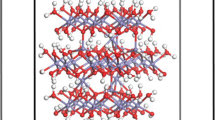Abstract.
Three principles, namely, a neutrality principle, a stoichiometry principle, and a coordination principle are proposed as criteria for building up cluster models of metal oxides. Particular attention is focused on how to cut out a stoichiometric cluster which possesses the smallest boundary effect for a given cluster size. Several criteria for determining self-consistently the magnitudes of embedding point charges are discussed. The problem of how the methods of embedding affect the calculated electronic properties of the substrate cluster and the adsorption properties are investigated. It is that a better cutout cluster, which interacts less with its surroundings, would depend less on the embedding scheme, while a better description of the surroundings would improve the quality of the cutout cluster. A simple point charge model provides a stable model of the oxide surface as well as of adsorption on the surface.
Similar content being viewed by others
Author information
Authors and Affiliations
Additional information
Received: 26 June 1998 / Accepted: 17 September 1998 / Published online: 23 February 1999
Rights and permissions
About this article
Cite this article
Xu, X., Nakatsuji, H., Lu, X. et al. Cluster modeling of metal oxides: case study of MgO and the CO/MgO adsorption system. Theor Chem Acc 102, 170–179 (1999). https://doi.org/10.1007/s002140050488
Issue Date:
DOI: https://doi.org/10.1007/s002140050488




